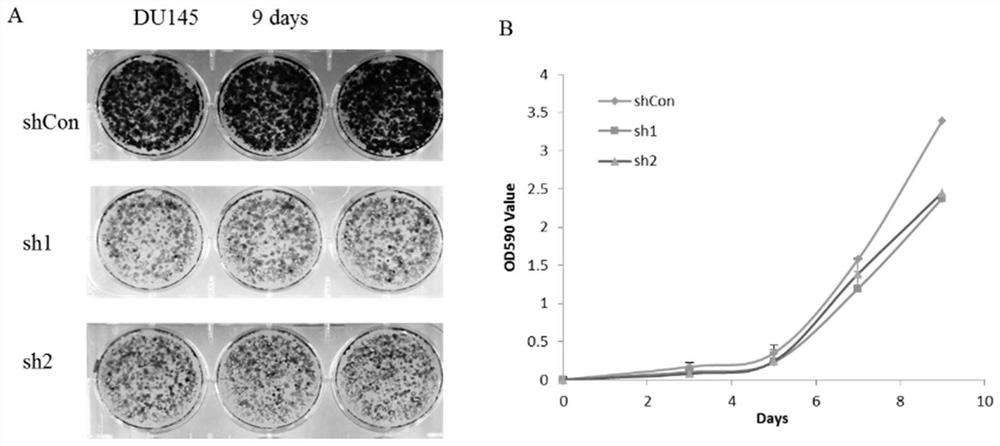A stable cell line of du145 with low expression of gfpt1 and its construction and application
A DU145, low-expression technology, applied in the field of cell biology, biochemistry and molecular biology, can solve the problems of the survival period and overall survival of triple-negative breast cancer patients.
- Summary
- Abstract
- Description
- Claims
- Application Information
AI Technical Summary
Problems solved by technology
Method used
Image
Examples
preparation example Construction
[0032] Preparation of protein samples
[0033] 1) Prepare RIPA protein lysis solution (100ul per 600mm petri dish) and add protease inhibitors.
[0034] 2) Collect the cells, wash the cells with pre-cooled PBS, blow off the cells with the prepared protein lysis solution, transfer the cells to a centrifuge tube, put them into a DNA mixer and mix well, 4°C for 30 min.
[0035] 3) Put the centrifuge tube into a centrifuge, 13,000 rpm at 4°C for 15 minutes, and transfer the supernatant to another centrifuge tube.
[0036] 4) Determination of protein concentration by BCA method
[0037] Blank: RIPA
[0038] Mix 20μl of BSA with different concentrations (0.125μg / μl, 0.25μg / μl, 0.5μg / μl, 1μg / μl, 2μg / μl) to prepare a standard and dilute 2μl of the sample to 18μl of RIPA.
[0039] BCA system: A:B=50:1 ratio to configure the measurement solution, finally according to 200μl BCA + 20μl sample or standard, after shaking, incubate at 37°C for 30min, and measure the protein concentration ...
example 1
[0072] Example 1 GFPT1 promotes tumor cell proliferation.
[0073] The proliferation efficiency of tumor cells was detected by crystal violet staining in DU145 cells differentially expressing GFPT1. 3000 cells were seeded in a twelve-well plate, and the cells were taken out on the 3rd, 5th, 7th, and 9th day for crystal violet staining. The cells were washed with acetic acid, and the values were read with a microplate reader to draw the cell proliferation curve. like figure 1 Low expression of GFPT1 is shown to inhibit cell proliferation.
example 2
[0074] Example 2 GFPT1 regulates AMPK phosphorylation.
[0075] The constructed cell line with differential expression of GFPT1 was used to verify the effect of GFPT1 on AMPK phosphorylation. The cells of differential expression of GFPT1 and the corresponding control group were subjected to AMPK activation (such as adding 2-DG treatment), and AMPK antibody was used by WesternBlot. And AMPK Thr172 phosphorylation antibody, and AMPK-regulated ACC signaling pathway antibody, observe the change trend of AMPK protein, AMPK phosphorylation and corresponding signaling pathway in cells, and prove that GFPT1 regulates AMPK signaling pathway such as figure 2 shown.
[0076] The above experiments show that GFPT1 has an important biological function in the occurrence and development of tumors and can regulate the phosphorylation of AMPK. Therefore, low expression of GFPT1 can inhibit the growth of prostate cancer, which is helpful for GFPT1 in cancer diagnosis, prognosis, treatment, and ...
PUM
 Login to View More
Login to View More Abstract
Description
Claims
Application Information
 Login to View More
Login to View More - R&D
- Intellectual Property
- Life Sciences
- Materials
- Tech Scout
- Unparalleled Data Quality
- Higher Quality Content
- 60% Fewer Hallucinations
Browse by: Latest US Patents, China's latest patents, Technical Efficacy Thesaurus, Application Domain, Technology Topic, Popular Technical Reports.
© 2025 PatSnap. All rights reserved.Legal|Privacy policy|Modern Slavery Act Transparency Statement|Sitemap|About US| Contact US: help@patsnap.com


